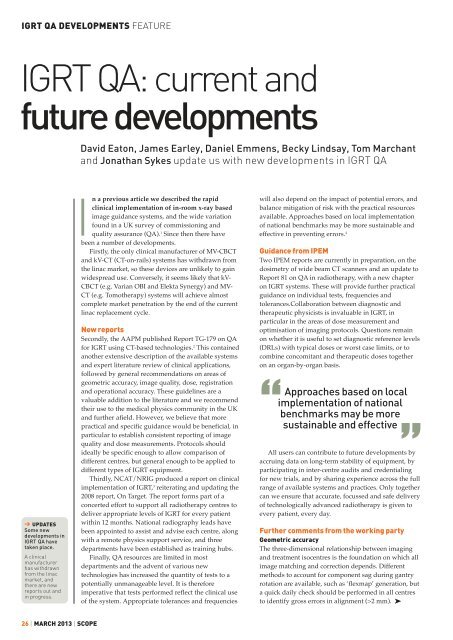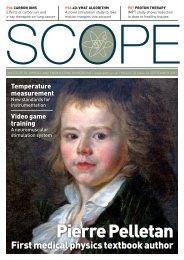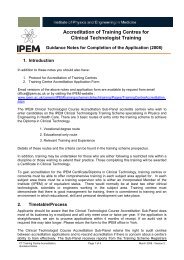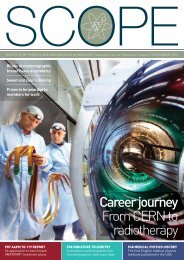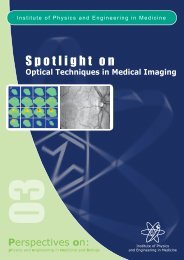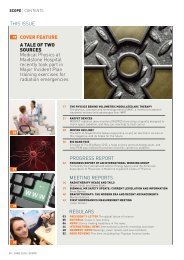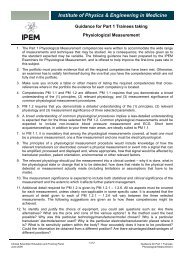March 2013 - Institute of Physics and Engineering in Medicine
March 2013 - Institute of Physics and Engineering in Medicine
March 2013 - Institute of Physics and Engineering in Medicine
Create successful ePaper yourself
Turn your PDF publications into a flip-book with our unique Google optimized e-Paper software.
IGRT QA DEVELOPMENTS FEATUREIGRT QA: current <strong>and</strong>future developmentsDavid Eaton, James Earley, Daniel Emmens, Becky L<strong>in</strong>dsay, Tom <strong>March</strong>ant<strong>and</strong> Jonathan Sykes update us with new developments <strong>in</strong> IGRT QA‘ UPDATESSome newdevelopments <strong>in</strong>IGRT QA havetaken place.A cl<strong>in</strong>icalmanufacturerhas withdrawnfrom the l<strong>in</strong>acmarket, <strong>and</strong>there are newreports out <strong>and</strong><strong>in</strong> progress.In a previous article we described the rapidcl<strong>in</strong>ical implementation <strong>of</strong> <strong>in</strong>-room x-ray basedimage guidance systems, <strong>and</strong> the wide variationfound <strong>in</strong> a UK survey <strong>of</strong> commission<strong>in</strong>g <strong>and</strong>quality assurance (QA). 1 S<strong>in</strong>ce then there havebeen a number <strong>of</strong> developments.Firstly, the only cl<strong>in</strong>ical manufacturer <strong>of</strong> MV-CBCT<strong>and</strong> kV-CT (CT-on-rails) systems has withdrawn fromthe l<strong>in</strong>ac market, so these devices are unlikely to ga<strong>in</strong>widespread use. Conversely, it seems likely that kV-CBCT (e.g. Varian OBI <strong>and</strong> Elekta Synergy) <strong>and</strong> MV-CT (e.g. Tomotherapy) systems will achieve almostcomplete market penetration by the end <strong>of</strong> the currentl<strong>in</strong>ac replacement cycle.New reportsSecondly, the AAPM published Report TG-179 on QAfor IGRT us<strong>in</strong>g CT-based technologies. 2 This conta<strong>in</strong>edanother extensive description <strong>of</strong> the available systems<strong>and</strong> expert literature review <strong>of</strong> cl<strong>in</strong>ical applications,followed by general recommendations on areas <strong>of</strong>geometric accuracy, image quality, dose, registration<strong>and</strong> operational accuracy. These guidel<strong>in</strong>es are avaluable addition to the literature <strong>and</strong> we recommendtheir use to the medical physics community <strong>in</strong> the UK<strong>and</strong> further afield. However, we believe that morepractical <strong>and</strong> specific guidance would be beneficial, <strong>in</strong>particular to establish consistent report<strong>in</strong>g <strong>of</strong> imagequality <strong>and</strong> dose measurements. Protocols shouldideally be specific enough to allow comparison <strong>of</strong>different centres, but general enough to be applied todifferent types <strong>of</strong> IGRT equipment.Thirdly, NCAT/NRIG produced a report on cl<strong>in</strong>icalimplementation <strong>of</strong> IGRT, 3 reiterat<strong>in</strong>g <strong>and</strong> updat<strong>in</strong>g the2008 report, On Target. The report forms part <strong>of</strong> aconcerted effort to support all radiotherapy centres todeliver appropriate levels <strong>of</strong> IGRT for every patientwith<strong>in</strong> 12 months. National radiography leads havebeen appo<strong>in</strong>ted to assist <strong>and</strong> advise each centre, alongwith a remote physics support service, <strong>and</strong> threedepartments have been established as tra<strong>in</strong><strong>in</strong>g hubs.F<strong>in</strong>ally, QA resources are limited <strong>in</strong> mostdepartments <strong>and</strong> the advent <strong>of</strong> various newtechnologies has <strong>in</strong>creased the quantity <strong>of</strong> tests to apotentially unmanageable level. It is thereforeimperative that tests performed reflect the cl<strong>in</strong>ical use<strong>of</strong> the system. Appropriate tolerances <strong>and</strong> frequencieswill also depend on the impact <strong>of</strong> potential errors, <strong>and</strong>balance mitigation <strong>of</strong> risk with the practical resourcesavailable. Approaches based on local implementation<strong>of</strong> national benchmarks may be more susta<strong>in</strong>able <strong>and</strong>effective <strong>in</strong> prevent<strong>in</strong>g errors. 4Guidance from IPEMTwo IPEM reports are currently <strong>in</strong> preparation, on thedosimetry <strong>of</strong> wide beam CT scanners <strong>and</strong> an update toReport 81 on QA <strong>in</strong> radiotherapy, with a new chapteron IGRT systems. These will provide further practicalguidance on <strong>in</strong>dividual tests, frequencies <strong>and</strong>tolerances.Collaboration between diagnostic <strong>and</strong>therapeutic physicists is <strong>in</strong>valuable <strong>in</strong> IGRT, <strong>in</strong>particular <strong>in</strong> the areas <strong>of</strong> dose measurement <strong>and</strong>optimisation <strong>of</strong> imag<strong>in</strong>g protocols. Questions rema<strong>in</strong>on whether it is useful to set diagnostic reference levels(DRLs) with typical doses or worst case limits, or tocomb<strong>in</strong>e concomitant <strong>and</strong> therapeutic doses togetheron an organ-by-organ basis.Approaches based on localimplementation <strong>of</strong> nationalbenchmarks may be more“susta<strong>in</strong>able <strong>and</strong> effective“All users can contribute to future developments byaccru<strong>in</strong>g data on long-term stability <strong>of</strong> equipment, byparticipat<strong>in</strong>g <strong>in</strong> <strong>in</strong>ter-centre audits <strong>and</strong> credential<strong>in</strong>gfor new trials, <strong>and</strong> by shar<strong>in</strong>g experience across the fullrange <strong>of</strong> available systems <strong>and</strong> practices. Only togethercan we ensure that accurate, focussed <strong>and</strong> safe delivery<strong>of</strong> technologically advanced radiotherapy is given toevery patient, every day.Further comments from the work<strong>in</strong>g partyGeometric accuracyThe three-dimensional relationship between imag<strong>in</strong>g<strong>and</strong> treatment isocentres is the foundation on which allimage match<strong>in</strong>g <strong>and</strong> correction depends. Differentmethods to account for component sag dur<strong>in</strong>g gantryrotation are available, such as ‘flexmap’ generation, buta quick daily check should be performed <strong>in</strong> all centresto identify gross errors <strong>in</strong> alignment (>2 mm). ‰26 | MARCH <strong>2013</strong> | SCOPE


